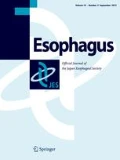Abstract
Background
Use of an endocytoscopy system (ECS) makes it possible to omit biopsy histology for esophageal squamous cell carcinoma (ESCC). However, for differential diagnosis of ESCC, the endocytoscopic characteristics of esophagitis should be clarified.
Methods
We examined the morphology of surface cells in 20 cases of gastroesophageal reflux disease (GERD) (Grade M: 6 cases, A: 5 cases, B: 1 cases, C: 4 cases, D: 4 cases), five cases of candida esophagitis, and one case of eosinophilic esophagitis. One endoscopist classified the lesions using the modified type classification, and one pathologist judged the endocytoscopy images as “neoplastic”, “borderline”, or “non-neoplastic”.
Results
All cases of Grade M, A, and B GERD were classified as “type 1 or 2” by the endoscopist. However, 3/8 Grade C and D GERD lesions that had been diagnosed as regenerative squamous epithelium from biopsy histology were diagnosed as Type 3. All Grade M, A, and B cases were interpreted by the pathologist as “non-neoplastic”, whereas 4/8 Grade C and D GERD lesions, including three cases of regenerating epithelium, were diagnosed as “borderline” on the basis of ECS images. In 80 % of candida esophagitis cases, hyphae were visualized as white areas. Eosinophilic esophagitis showed a slight increase of cell density with marked infiltration of inflammatory cells.
Conclusion
Some cases of severe GERD cannot be clearly distinguished from esophageal squamous cell carcinoma (ESCC) using ECS, and therefore at present, cases of ESCC coexisting with severe GERD should not be diagnosed by ECS alone and probably require biopsy. (UMIN000007627).




Similar content being viewed by others
References
Kumagai Y, Monma K, Kawada K. Magnifying chromoendoscopy of the esophagus: in vivo pathological diagnosis using an endocytoscopy system. Endoscopy. 2004;36:590–4.
Kumagai Y, Iida M, Yamazaki S. Magnifying endoscopic observation of the upper gastrointestinal tract. Dig Endosc. 2006;18:165–72.
Kumagai Y, Kawada K, Yamazaki S, et al. Endocytoscopic observation for esophageal squamous cell carcinoma: can biopsy histology be omitted? Dis Esophagus. 2009;22:505–12.
Kumagai Y, Kawada K, Yamazaki S, et al. Endocytoscopic observation of esophageal squamous cell carcinoma. Dig Endosc. 2010;22:10–6.
Kumagai Y, Takubo K, Iida M, et al. A tiny esophageal cancer which was accurately diagnosed by magnifying endoscopy and endo-cytoscopy system: report of a case. Esophagus. 2007;4:173–6.
Kumagai Y, Kawada K, Yamazaki S, et al. Prospective replacement of magnifying endoscopy by a newly developed endocytoscope, the ‘GIF-Y0002’. Dis Esophagus. 2010;23:627–32.
Kumagai Y, Kawada K, Yamazaki S, et al. Current status and limitations of the newly developed endocytoscope GIF-Y0002 with reference to its diagnostic performance for common esophageal lesions. J Dig Dis. 2012;13:393–400.
Chao YK, Kawada K, Kumagai Y, et al. On endocytoscopy and post-therapy pathologic staging in esophageal cancers, and on evidence-based methodology. Ann N Y Acad Sci. 2014;1325:1–7.
Kumagai Y, Kawada K, Higashi M, et al. Endocytoscopic observation of various esophageal lesions at 600×: can nuclear abnormality be recognized? Dis Esophagus. 2015;28:269–75.
Hoshihara Y, Hashimoto M. Endoscopic classification of reflux esophagitis (in Japanese with English abstract). Nippon Rinsho. 2000;58:1808–12.
Takubo K. Esophagitis and esophageal ulcer. In: Pathology of the Esophagus. New York: Springer; 2007. p. 84–97.
Papadopoulou A, Dias JA. Eosinophilic esophagitis: an emerging disease in childhood—review of diagnostic and management strategies. Front Pediatr Rev. 2014; 21;2:129.
Inoue H, Kudo S, Shiokawa A. Technology insight: Laser-scanning confocal microscopy and endocytoscopy for cellular observation of the gastrointestinal tract. Nat Clin Pract Gastroenterol Hepatol Rev. 2005;2:31–7.
Kodashima S, Fujishiro M, Takubo K, et al. Ex-vivo study of high-magnification chromoendoscopy in the gastrointestinal tract to determine the optimal staining conditions for endocytoscopy. Endoscopy. 2006;38:1115–21.
Fujishiro M, Takubo K, Sato Y, et al. Potential and present limitation of endocytoscopy in the diagnosis of esophageal squamous-cell carcinoma: a multicenter ex vivo pilot study. Gastrointest Endosc. 2007;66:551–5.
Fujishiro M, Kodashima S, Takubo K, et al. Detailed comparison between endocytoscopy and horizontal histology of an esophageal intraepithelial squamous cell carcinoma. Dis Esophagus. 2008;2:181–5.
Inoue H, Kazawa T, Sato Y, et al. In vivo observation of living cancer cells in the esophagus, stomach, and colon using catheter-type contact endoscope, “Endo-Cytoscopy system”. Gastrointest Endosc Clin N Am. 2004;14:589–94.
Eberl T, Jechart G, Probst A, et al. Can an endocytoscope system (ECS) predict histology in neoplastic lesions? Endoscopy. 2007;39:497–501.
Pohl H, Koch M, Khalifa A, et al. Evaluation of endocytoscopy in the surveillance of patients with Barrett’s esophagus. Endoscopy. 2007;39:492–6.
Inoue H, Sasajima K, Kaga M, et al. Endoscopic in vivo evaluation of tissue atypia in the esophagus using a newly designed integrated endocytoscopy: a pilot study. Endoscopy. 2006;38:891–5.
Minami H, Yamaguchi N, Matsushima K, et al. Improvement of endocytoscopic findings after per oral endoscopic myotomy (POEM) in esophageal achalasia; does POEM reduce the risk of developing esophageal carcinoma? Per oral endoscopic myotomy, endocytoscopy and carcinogenesis. BMC Gastroenterol. 2013;30(13):22.
Acknowledgments
This study was supported by MEXT KAKENHI Grant number 26461047.
Author information
Authors and Affiliations
Corresponding author
Ethics declarations
Conflict of interest
All authors declare that they have no conflicts of interest.
Human rights statement and informed consent
All procedures followed were in accordance with the ethical standards of the committees responsible for human experimentation (institutional and national) and with the Helsinki Declaration of 1964 and later versions. Informed consent for inclusion of tissue samples in this study was obtained from all patients or their representatives.
Rights and permissions
About this article
Cite this article
Kumagai, Y., Takubo, K., Kawada, K. et al. Endocytoscopic observation of various types of esophagitis. Esophagus 13, 200–207 (2016). https://doi.org/10.1007/s10388-015-0517-1
Received:
Accepted:
Published:
Issue Date:
DOI: https://doi.org/10.1007/s10388-015-0517-1




